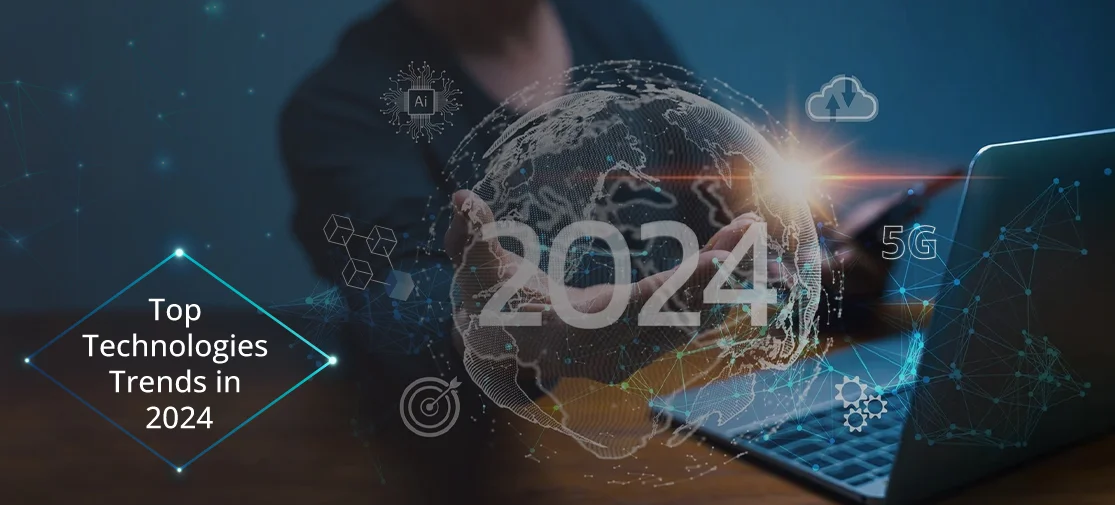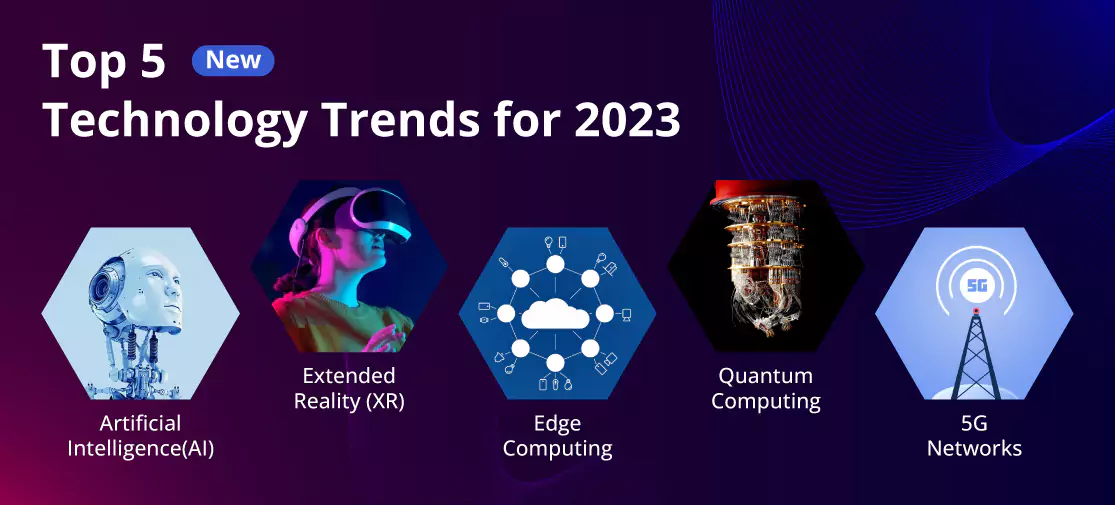Introduction
There is no doubt that technology is continually evolving, with new trends and improvements being brought in organisations from Web development to Mobile applications every IT solution is being updated. Therefore, to remain competitive in the business sector, one must keep up with the latest technological advancements, as they create new demands in the market.
Innovation in the use of current technology is quickly altering how organisations operate even as new technologies are created. This change is being accelerated by improvements in processing power, data collecting, and connection.
Technology trends in 2024
In the coming year 2024 promises to come out with top technologies and upgrades making the IT sector even more organised and advanced. So, let's dive deep into the new trends and technology that will be used in every sector.
Artificial intelligence (AI) technology
This upcoming technology has continuously received the highest innovation as it simplifies various tasks, from research assistants, database management, chatbots, risk assessment for insurance policies, and financial advisory all are handled by artificial intelligence.
Within a few years, analysts predict that all software will use AI at some level as it offers the opportunity to continuously tailor products and services providing a competitive advantage.
This open-source AI system has removed bottlenecks in finance, healthcare, manufacturing, and dozens of other industries.
Types of AI technology
AI is a vast technology which cannot be combined into a single category for which various types are defined for it. So, here are the 4 types of AI technology explained
- Reactive machines
An AI system that doesn't require any memory storage and performs a specific task which means it delivers the same output. The reasons that are mentioned as reactive machines are because they receive the customer data and according to the search history deliver recommendations to the same person.
- Limited memory machines
Unlike reactive machines, this AI can see into the past and track particular objects or events throughout time, in contrast to reactive machines. The AI is then programmed with the results so that it can act on input from both the past and the present. However, this data isn't stored in the AI's memory due to memory constraints. As the AI acquires knowledge of more data over time, it gets better.
- Theory of mind
This is a predicted AI which has yet to be released in the market. This future AI technology can understand the thoughts and the emotions of human behaviour. Theory of mind will be the AI machine will be able to understand the intentions and predict behaviour to simulate human relationships.
- Self awarness
Not yet been released but it’s a step beyond the theory of mind as this AI has self-sense and awareness with a conscience understanding of its existence making it able to predict emotional feelings. Self-awareness must a long way as there is a lot to uncover about the human brain's intelligence.
Internet of things (IOT) revolution
A network that is interconnected with devices that collect and exchange data. IoT devices generate a vast amount of data allowing us to make better-informed business decisions.
This will make it possible to implement new use cases, like remote monitoring and control of industrial operations, as well as smart cities and households. Therefore, the number of connected devices will continue to grow, leading to more data collection and analysis for improved efficiency and automation.
IoT in business
Currently, IoT is being used in various sectors as it can transform the business as the way it is processed now.
- Predictive Maintenance
With enabled sensors and devices the business can predict real-time visibility into its operations allowing them to optimise their process and resources which prevent them from downtime and can reduce maintenance costs.
- Supply Chain Optimization
With the help of real-time visibility supply chain allows them to track the shipment. Monitor inventory level, and optimise logistics. Therefore, this reduces cost, improves efficiency and enhances customer satisfaction.
- Customer Experience
It offers a personalized and context experience to its customers. So, IoT tracks customers’ preferences and behaviours and offers personalized recommendations or promotions.
5G technology expansion
5G the mobile internet connection technology is gradually becoming the trending tech for its speedy connection with minimal delays, with a smooth immediate 4K streaming or lag-free online unity gaming.
Moreover, it helps businesses to scale technology initiatives as it provides better storage capacity compared to previous generations allowing thousands of devices to seamlessly communicate and installation of new applications.
What is 5G capable of?
5G won't just won't improve your network connection but it will offer new opportunities that deliver groundbreaking solutions in
- Connected vehicle : Vehicles will be accelerated by the 5G network making more faster, accessible and secure.
- Immersive gaming : With an elevated 5G technology you can get an immersive experience giving you a unique feel of gaming.
- Event experiences : Stadiums and venues and going larger and live. As 5G technology increases the network capacity with multi-sensory viewing capabilities.
- Connected homes : Society will be adapted towards a smart home that will be enabled with all wireless access solutions and all operated through 5G.
Augmented reality (AR) developments
Organisations are rapidly applying this technology in every sector to give a 3D vision and sound with a sense of touch and location data allowing them to react and alter their virtual environment in real time.
“Also Read: How to create an AR application using react native?”
But, if we have a look at 2024 it may eliminate the bulky headset and may transform into more lighter and portable devices with just a requirement of WiFi that gives an incredible experience in the metaverse, a shared, persistent virtual world that users can access across different devices and platforms.
Types of augmented reality apps
Various types of Augmented reality applications differ in the solution depending on the business goals that you are pursuing with your application.
- Market-based AR app
This AR is based on image recognition or image markers. When the application detects the image it recognises it and interprets the digital information. QR codes can be explained as a perfect example of it.
- Marker-less AR
Augmented reality solutions that are location-based, or marker-less, are the most often utilised type of AR. These apps generate AR objects depending on the user's present location by utilising GPS, accelerators, compasses, and other location detectors in place of markers.
- Projection AR
These kinds of applications depend on visual optical. To pinpoint an object's exact location and take appropriate action, they employ complex algorithms and gather information from several sensors.
- Superimposition AR
Superimposition AR refers to the partial or complete replacement of an augmented view of an object with its original view. Object identification is essential in this kind of AR because, without it, an app cannot detect the original object and replace it with an augmented one.
Blockchain transformations
While blockchain technology initially gained recognition through cryptocurrencies, it has evolved far beyond. Decentralised finance (DeFi) is on the rise, and blockchain applications are being explored across diverse industries.
Blockchain technology allows for safe peer-to-peer transactions, data integrity, and the creation of tamper-proof digital ledgers. In addition to assisting with data privacy issues, this 2024 technology trend can help you eliminate with middlemen in transactions.
Trend of blockchain technology in 2024
Currently, blockchain is the only sign of promising technology in the coming future. Blockchain is undoubtedly a quickly developing technology, having a significant impact on everything from NFT to metaverse.
- NFT Boom : NFT over is known as (Non-Fungible Tokens) which serve as ownership or authentication for a variety of physical and digital goods.
- Tokenization of Assets : The process of representing tangible assets as digital tokens on a blockchain network is known as blockchain asset tokenization.
- Metaverse : In recent years, there has been an increase in interest in and growth for both blockchain technology and the metaverse. The concept of the metaverse is a virtual reality environment where users may interact with digital content.
- Interoperability : It’s one of the most important developments in blockchain in 2024 because it allows a networked ecosystem to grow, allowing various blockchains to collaborate and take advantage of each other's advantages.
Quantum computing breakthroughs
Quantum Computing has always been buzzing as real-world applications for this type of computing.
The year 2024 promises to achieve it. If we look at the traditional systems it operates in binary code of 0-1 but, quantum computing works on qubits which allows a piece of data to exist in two states at the same time (both 0 and 1). So, with this tech trend, the speed of computing will be increased and complex calculations will be solved within a minute.
What does quantum offer in 2024?
Quantum Computing has completely overtaken the traditional system, but it's not only the binary code as there are various promises made such as
- Error Correction
Quantum computers are inherently prone to errors due to factors such as decoherence and environmental interference. Researchers were actively working on improving error correction techniques to make quantum computations more reliable.
- Quantum Communication
The field of quantum communication involves leveraging the principles of quantum mechanics to secure communication channels. Advances in quantum key distribution (QKD) and quantum teleportation were expected to continue.
- Quantum Algorithms and Applications
Researchers were actively developing new algorithms for quantum computers that could outperform classical algorithms in certain applications. This includes optimization problems, machine learning, and cryptography solutions as well.
Conclusion
As we navigate the technological landscape of 2024, the key lies in adaptability. The trends mentioned above are not isolated but interconnected, creating innovations that will shape our future. Staying informed and embracing these changes is the key to thriving in the digital era.




